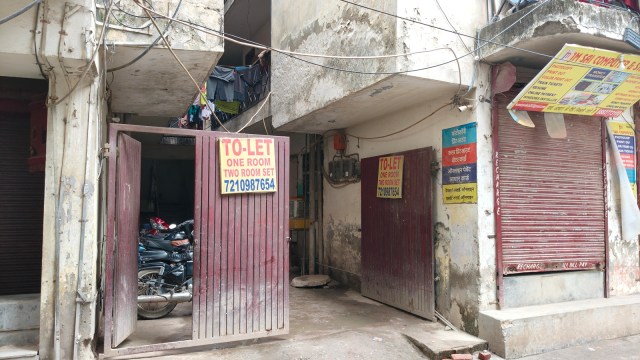‘Ek darr sa lagta hai’: A year after family of five was found dead in South Delhi flat, unease lingers in locality
In September last year, the decomposing bodies of Heerlal Sharma (46) and his four daughters were found in the two-room flat. What made them take the step?
 C-4 in Chauhan Mohalla, Ranpuri village, where Heeralal and his four daughters lived (Express)
C-4 in Chauhan Mohalla, Ranpuri village, where Heeralal and his four daughters lived (Express)For several minutes, neighbours knocked repeatedly on the door of flat C-4 in Chauhan Mohalla. No one answered. Flies swarmed around the entrance, and a strong, foul smell lingered near the main door.
It was around 9 am on September 28 last year — a Saturday morning like any other in Rangpuri village, in Southwest Delhi’s Vasant Kunj. But inside C-4, something was amiss.
In the flat lived Heerlal Sharma (46) and his four daughters. They were tenants, renting the modest two-room space on the third floor of a residential building in the narrow lanes of Rangpuri.
The flat was tucked into a corner of the third floor in a four-storey building. There were seven units on each floor. All were rented, except for one on the ground floor where the caretaker lived with his family. Most residents worked as drivers, factory workers, and shop assistants; some also worked at the Delhi Airport around 8 km away.
Concerned over the strong stench, neighbours knocked a few more times on the door of C4 before alerting the caretaker. He contacted the building’s owner, who lived nearby. Soon, the police were called.
With the door locked from the inside, police had to break it open — and made a grim discovery. Heeralal and his four physically challenged daughters — Neetu (26), Nikki (24), Neeru (23), and Nidhi (20) — were found dead in two separate rooms.
There were no signs of struggle. The four women were lying on the same bed. Heeralal was found in another room, seemingly asleep at the time of death. Their bodies were in a highly decomposed state.
 The flat was on the third floor of a residential building in the narrow lanes of Rangpuri (Express)
The flat was on the third floor of a residential building in the narrow lanes of Rangpuri (Express)
Police suspected it was a mass suicide, possibly after consuming a poisonous substance mixed into cold drinks and sweets. They found four packets of ‘sulphas’ tablets, five empty glasses, and a spoon near the bodies of the women.
A red kalaya (sacred thread) tied around their waists led police to initially suspect that certain rituals may have been performed prior to their deaths.
“The scene in the room reminded us of the 2018 Burari deaths, where 11 members of the same family died under mysterious circumstances,” said a police officer who was among the first team members to reach the spot after the PCR call.
“We immediately informed our senior officers, and a probe was initiated.”
However, investigators later ruled out any occult angle. “We did not find evidence of occult practices being performed… The deaths appear to have stemmed from Heerlal’s depression, reportedly due to the condition of his daughters,” the officer said.
For nearly 28 years, Heeralal had worked as a carpenter at the Indian Spinal Injuries Centre (ISIC) in Vasant Kunj. He would earn around Rs 25,000 a month.
But after his wife died of cancer in 2023, police said Heerlal went into shock. “He had to take care of his daughters, which also forced him to quit his job last January,” the officer said.
“With no income and no savings, he was struggling. We believe it was a suicide pact — he convinced his daughters to consume the poison. That is perhaps why he bought some sweets and cold drinks, to make the bitter taste of the poison a little milder,” the officer added.
The bodies were sent for post-mortem, forensic examinations were conducted, and statements of Heeralal’s brothers, family members, relatives and friends — those he would often talk to — were recorded. Police said none of them ever thought that he would take such a step, although they did reveal that he had been struggling.
The flat, meanwhile, was cleaned with chemicals, and crucial evidence was collected. Police sealed the premises and began inquest proceedings. No foul play was suspected, though the exact circumstances of the deaths remained unclear.
A year later: New tenants, but questions remain
When The Indian Express visited Rangpuri a year later, the broken, narrow roads leading to Chauhan Mohalla — where this three-storey building is located about a kilometre from the Delhi-Gurgaon Expressway — remained unchanged.
A board with the words, ‘To Let One Room and Two Room Set’ with a mobile number of the owner hung on the main gate.
Opposite the building, a multi-storey complex that houses shops like a medical store, a general store, and a hair salon were shut. A nearby vegetable vendor explained, “This market usually remains closed in the afternoon.”
The maroon paint on the main gate, as well as on the doors and windows of the flats in this building, remained unchanged.
However, Flat C-4 was no longer sealed. Several pairs of dusty, mud-covered shoes lay scattered outside.
A man, around 35, opened the door after a knock. He appeared to have just woken up. Inside, a few more men were seen sleeping.
“We’ve been staying here for the past two months,” he said, adding that they were from Nashik, Maharashtra, and were employed at a construction site.
Asked if they knew anything about the incident that happened in the house a year ago, he replied they didn’t and shut the door.
Next door, Flat C-3 was locked. No one answered despite repeated knocking.
Hearing the knocks, a middle-aged woman living in the building stepped out from another flat. “Kaun rehta hai in dono makaano mein humein nahi pata. Lekin yeh dono hi makaan kafi dino se band the. Kuch dino se ab dono mein koi reh raha hai. (We don’t know who lives in these flats. But these houses remained vacant for many months after the incident. Some people recently moved into both flats),” she said.
When asked about the deaths, she hesitated. “No one wants to talk about it,” she said quietly.
Another woman, who wished to remain anonymous, came out to join her. She said, “Hum log aaj bhi 7 baje ke baad ghar se bahar nahi aate… ek darr sa lagta hai (We still don’t go out after 7 pm. We feel a bit scared).”
A neighbour passing by remarked, “Dar ki kya baat hai? Jo hona tha ho gaya (What is there to be scared of? Whatever had to happen, happened).”
The second woman recalled Heeralal and his family. “I shifted here in 2021, and aunty used to talk to us,” the neighbour said. “She took care of all the daughters, while uncle would go to work. A relative who lived with his family nearby would sometimes come to meet them.”
“They were quiet… But after aunty’s death, the family went into shock. Uncle’s youngest daughter had been going to school but stopped. All four of them were affected by some physical disabilities.”
She said C-4 was unsealed almost four months after the incident. “The owner performed rituals in the house and began looking for tenants. Two people rented the house but left within a few days. Then a couple moved in, but they also shifted elsewhere within a week. Now, we’ve heard that some men have been staying there.”
The woman said many residents moved out after the tragedy and few of the original tenants remain. Most families now living on the third floor are new.
Caretaker Sonu, who lives on the ground floor, confirmed that the flat was reopened after the police investigation concluded.
A senior police officer said: “Unlike the Burari case, circumstantial evidence suggested there was no occult practice involved. The glasses and drinks indicated they consumed ‘sulfas’ tablets and died in their sleep. The post-mortem reports confirmed death due to poisoning, but the actual cause can only be confirmed after the viscera reports, which are still awaited, arrive.”
While the police probe suggests a suicide pact, some still believe the deaths were the result of occult practices gone wrong. Until the viscera test results arrive, the true cause behind this family’s tragedy remains unsolved.







